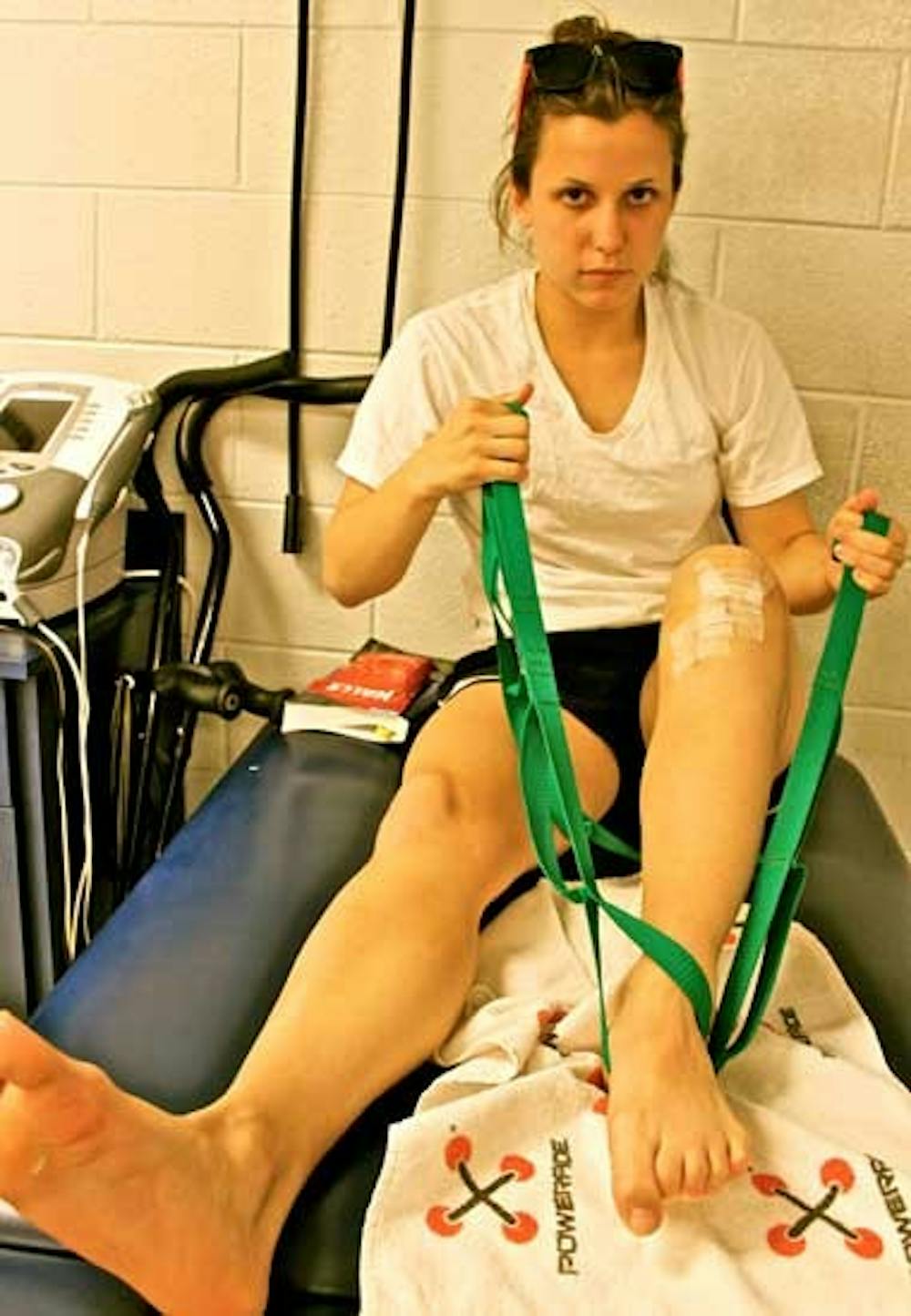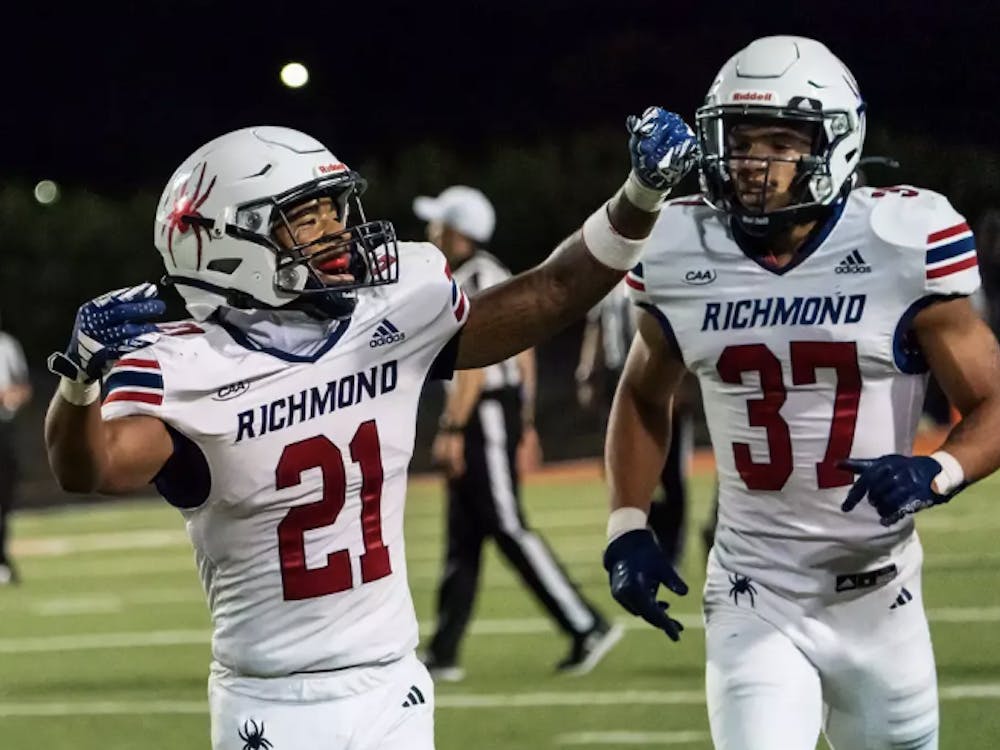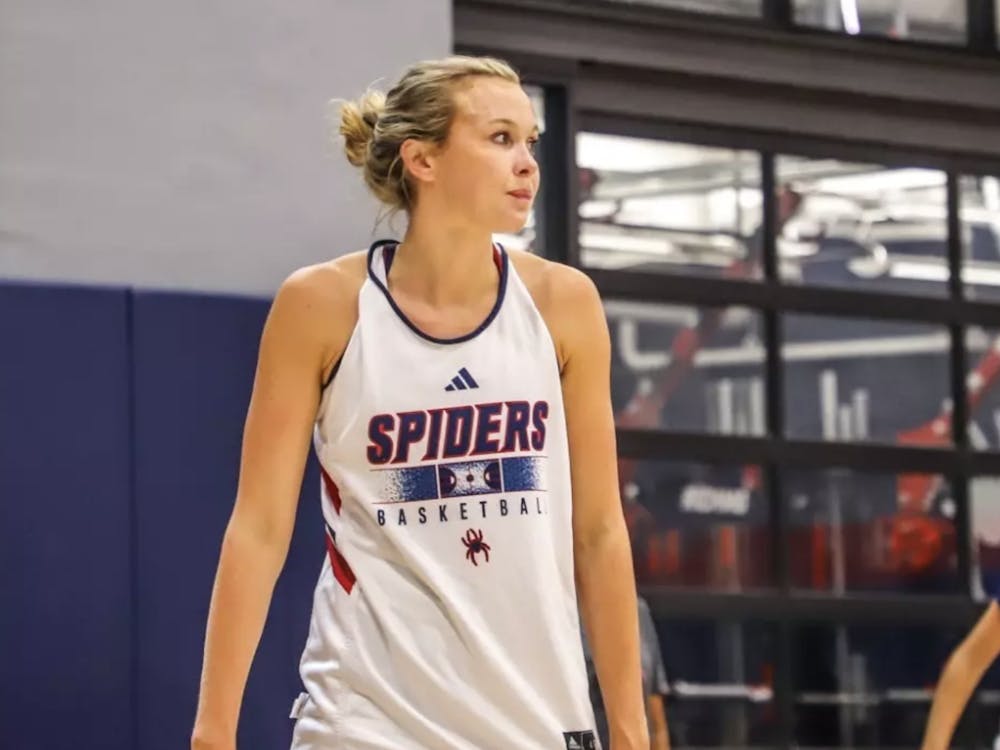Above freshman Kristen Lybert's bed hangs a 2011 women's soccer schedule with the date Sept. 30 highlighted.
Each night as she props her left leg onto a stack of pillows and tightens her leg brace, it is one of the last things she looks at before she falls asleep. Next to her bed is a pharmacy of pain medications -- with few pills actually taken -- and beneath her bed is an ice machine buried under clothes.
For anyone who knows Lybert, you may think this story is a flashback to September when she tore her ACL during the second game of the regular season, but for Lybert it's anything but a flashback.
On Feb. 19, five and a half months after reconstructive knee surgery on her anterior cruciate ligament, Lybert was cleared to play soccer again.
Standard ACL recovery is around six months so her timeline was just right, she said. She passed all necessary tests conducted by University of Richmond athletic training staff members and had an MRI done as the final piece of evidence that she was ready to play again, she said.
But just over a month later on March 22 while Lybert was making a standard cut during the team's game against Virginia Commonwealth University, she re-tore her ACL. It was her second game back from being cleared and she had played a full 90 minutes in the game against the College of William and Mary the week before, she said.
"I knew I could redshirt the first time I did it and I wouldn't be missing a season, so I felt if it was going to happen that was the time to do it," she said. "I thought, 'I'll be back next year better than ever' and it would be OK, but the second time was about a thousand times harder to hear. It definitely hit way harder because I didn't think I would have a chance to come back and play in the fall so the news hit me like rocks."
Despite her initial fears of missing a second straight season, Lybert will have the chance to play next fall, she said.
There are three surgeries that can be done to fix a torn ACL. A piece of the injured person's hamstring can be taken and used as the new ACL, a section of the patellar tendon of the injured person can be used as the new ACL or the injured person can use an allograft, which is the transfer of a tissue from a cadaver as the new ACL.
For Lybert's first surgery she used a section of her hamstring and for hersecond surgery she used her patellar tendon. Her estimated recovery time is between four and five months, she said, which drops her right at the start of conference play next season.
"The goal is to be running in July so I can go through all of the preseason conditioning with the team in August and then hopefully be ready to play by the end of September," she said. "I know I have a long way to go, but I think going through the first one will help me this time around."
Being able to tell the difference between her knee being sore and her knee being in pain will help move her rehab forward, she said. Using the experience of tearing it the first time will help her measure how her recovery is going, she said.
Although Lybert said she had not felt pressured into coming back after her first surgery following successful completion of all clearance tests and after receiving clearance from her doctors, looking back she was not sure she felt ready.
"Everything aligned right," she said. "The MRI was good. Doctors and trainers said I looked good.
"If you're going to tell me all of this and ask me if I want to play of course I'm going to say yes. Maybe I should have said no to playing, but as an athlete are you ever going to say no?
"I think I heard the word 'cleared' and I thought 'I can do anything I want,' but realistically maybe I couldn't. The hard thing is if it's your first time coming back from reconstructive knee surgery how are you supposed to know what feels right and what doesn't?"
Katie Kaschub, an athletic trainer for the university, said as much as she would have liked to pinpoint why Lybert re-tore her ACL, there was not one thing that could be blamed.
"There are many factors that may cause an athlete to re-tear an ACL," she said. "One big thing to consider is the basic anatomy of the individual's knee. Factors that predispose an athlete to suffer a non-contact ACL injury one time may still be present regardless of the strength and rehabilitation of the new ACL graft.
"These things include the person's Q-angle (relation of hips to patella/tibia alignment) and narrowing of the intercondylar notch where the ACL passes (although some orthopaedic surgeons may widen this notch while reconstructing the ACL).
"Other risk factors include mechanical deficiencies including jump and landing techniques. That is why there is so much emphasis placed on proper mechanics during rehab, in an effort to re-train the body to use correct biomechanics."
What makes understanding ACL tears even harder is that there isn't a perfect formula for tearing it, Kaschub said. Some injuries are sustained during contact and others are just freak accidents during non-contact activity, (which is what happened to Lybert both times), she said.
There is some evidence that females are at a greater risk than males of tearing an ACL, Kaschub said.
"Female athletes are two to three times more likely to tear their ACL because they have a wider Q-angle (hips are wider than knees)," she said. "Some studies have found that young females suffer more non-contact ligament injury during the ovulatory phase of their menstrual cycle and that female sex hormones may have an effect on the structure and composition of the ligament. Other studies have demonstrated increased knee laxity during certain phases of the menstrual cycle, but these studies are not statistically strong."
Amid the lack of scientific answers, rehabilitation is critical for those who want to compete in athletics, Lybert said. Six days a week Lybert will have to do rehab to get back to a competitive level, she said.
Going to rehab and doing everything possible to get a little better each day is the same mindset as stepping onto the field each day to practice, she said. She admitted the initial weeks of the process are less than exciting, but it's the only way to return full strength, she said.
"You have to do everything you can do every day to get better," she said. "If I was out playing soccer I would be working every day as hard as I could at practice to get better. In rehab I'm still working as hard as I can to be a better soccer player, there's just a little intermission now."
During her first intermission, Lybert said she had learned there is life after University of Richmond soccer.
"Realistically I know I'm not going to go to the pros," she said. "But I love soccer and I want to be around it for as long as I can, but there is life after a sport. I learned I can be a real person outside of sports through all of this."
As Lybert continues her rehabilitation, which will force her to stay in Richmond for the summer to be ready to play in the fall, her positivity will remain consistent, but she can't help but wonder why this happened all over again, she said.
"The hardest part about all of this is that I felt I did it right the first time," she said. "I felt I did what they told me to and I pushed as hard as I could without going too far. I played by the rules and did what they told me to even though I wanted to do so much more, yet this still happened."
Contact staff reporter Rachael Bilney at rachael.bilney@richmond.edu
Support independent student media
You can make a tax-deductible donation by clicking the button below, which takes you to our secure PayPal account. The page is set up to receive contributions in whatever amount you designate. We look forward to using the money we raise to further our mission of providing honest and accurate information to students, faculty, staff, alumni and others in the general public.
Donate Now



